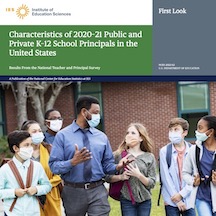The Status of Women as School Principals in the United States
Posted on Jan 04, 2023 | Comments 1
 A new report from the U.S. Department of Education offers statistics on K-12 school principals in the United States. Some of the data is broken down by gender.
A new report from the U.S. Department of Education offers statistics on K-12 school principals in the United States. Some of the data is broken down by gender.
Overall, 57.4 percent of all K-12 school principals in the United States in the 2020-21 academic year were women. Women were 56 percent of all public school principals and 62.8 percent of private school principals.
In the nation’s public schools, women were 68.6 percent of all principals in elementary schools. But women were 43.7 percent of middle school principals and only 35.5 percent of high school principals.
Women were more likely to be principals in city schools than in rural areas. And women were more likely to be principals in schools where there were large numbers of students who qualified for free or reduced-price lunches.
In private schools, women were 75 percent of all elementary school and middle school principals but only 44.6 percent of high school principals. Women were far more likely to be principals in schools with less than 100 students but men were a majority of principals of private schools with more than 500 students.
Women were 68.5 percent of principals at Catholic schools but only 56.1 percent of principals at other religious private schools
The full report, Characteristics of 2020–21 Public and Private K–12 School Principals in the United States: Results From the National Teacher and Principal Survey, may be downloaded here.
Filed Under: Research/Study









[…] Averill: According to Peter Earle, who compared his data on the late 17th and early 18th century to the 1851 census, the conditions he found among waged women workers persisted into the 19th century. He notes that “the general structure of occupations [was] very similar” in both periods, with the top four employments for women unchanged.[29] And we can see this still today, of course. Professions that became associated with women, like teaching, nursing, and various cleaning work, have long been underpaid. And even as those professions, coded as feminine, are underpaid, when men take those jobs, they tend to earn higher wages than their female counterparts. In one 2004 study, male nurses on average earned a higher wage premium, as they entered or were given management or in anesthetics.[30] Similarly among teachers, men on average receive higher wages than women, and dominate better-paid administrator positions. In 2020-21, women were 56 of all principles in public schools, but only 35.5 percent of high school principles. […]